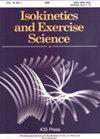患有和未患有髌骨肌腱病的国家奥林匹克运动员的生态动态飞轮测力计深蹲表现特征
IF 0.7
4区 医学
Q4 ENGINEERING, BIOMEDICAL
引用次数: 0
摘要
背景:髌骨肌腱病(Patellar tendinopathy,PT)是一种常见的损伤,涉及在动态体育活动中膝关节伸肌偏心(ECC)收缩不足。然而,利用飞轮测力计深蹲,患有和未患有髌骨肌腱病的奥林匹克运动员在偏心(ECC)力量输出方面是否存在差异仍有待确定。目的:比较有和没有运动障碍的男女运动员的 ECC 峰值功率、同心(CON)功率、ECC/CON 功率比和运动速度。方法:纳入 40 名患有和未患有运动障碍的奥林匹克运动员,分析他们在不同负荷条件下的 ECC 功率、CON 功率、ECC/CON 功率比和运动速度(米/秒),并按性别进行分析。结果:男女 PT 组的 ECC 功率、ECC/CON 功率比和运动速度均明显低于非 PT 组(NPT)。在 NPT 组中,随着惯性负荷的增加,ECC 和 CON 功率明显增加,而在 PT 组和 NPT 组中,随着惯性负荷的增加,速度明显下降。结论:动态飞轮测力计评估有助于在不同动态深蹲条件下对患有 PT 的运动员进行定量诊断。该评估可用于制定深蹲性能测试、强化、调节和康复的标准化指南。本文章由计算机程序翻译,如有差异,请以英文原文为准。
Ecologically dynamic flywheel ergometer squat performance characteristics between national Olympic athletes with and without patellar tendinopathy
BACKGROUND: Patellar tendinopathy (PT) is a common injury involving inadequate eccentric (ECC) knee extensor contractions during dynamic sports activities. However, any discrepancies in ECC power output between Olympic athletes with and without PT utilizing a flywheel ergometer squat remain to be determined. OBJECTIVE: To compare peak ECC power, concentric (CON) power, the ECC/CON power ratio, and performance speed in female and male athletes with and without PT, respectively. METHODS: Forty Olympic athletes with and without PT were included and analyzed for ECC power, CON power, ECC/CON power ratio, and performance speed (m/s) under varying load conditions, with analyses separated by gender. RESULTS: The ECC power, ECC/CON power ratio, and performance speed of the PT group were significantly lower than those of the non-PT (NPT) group in both genders. ECC and CON power significantly increased with higher inertial loads in the NPT groups, whereas the speed significantly decreased as the inertial load increased in both PT and NPT groups. CONCLUSIONS: Dynamic flywheel ergometer assessments may help in the quantitative diagnosis of athletes with PT under differing dynamic squat conditions. This assessment may be used to create standardized guidelines for squat performance testing, strengthening, conditioning, and rehabilitation.
求助全文
通过发布文献求助,成功后即可免费获取论文全文。
去求助
来源期刊

Isokinetics and Exercise Science
医学-工程:生物医学
CiteScore
1.20
自引率
14.30%
发文量
37
审稿时长
>12 weeks
期刊介绍:
Isokinetics and Exercise Science (IES) is an international journal devoted to the study of theoretical and applied aspects of human muscle performance. Since isokinetic dynamometry constitutes the major tool in this area, the journal takes a particular interest in exploring the considerable potential of this technology.
IES publishes studies associated with the methodology of muscle performance especially with respect to the issues of reproducibility and validity of testing, description of normal and pathological mechanical parameters which are derivable from muscle testing, applications in basic research topics such as motor learning paradigms and electromyography. The journal also publishes studies on applications in clinical settings and technical aspects of the various measurement systems employed in human muscle performance research.
The journal welcomes submissions in the form of research papers, reviews, case studies and technical reports from professionals in the fields of sports medicine, orthopaedic and neurological rehabilitation and exercise physiology.
 求助内容:
求助内容: 应助结果提醒方式:
应助结果提醒方式:


